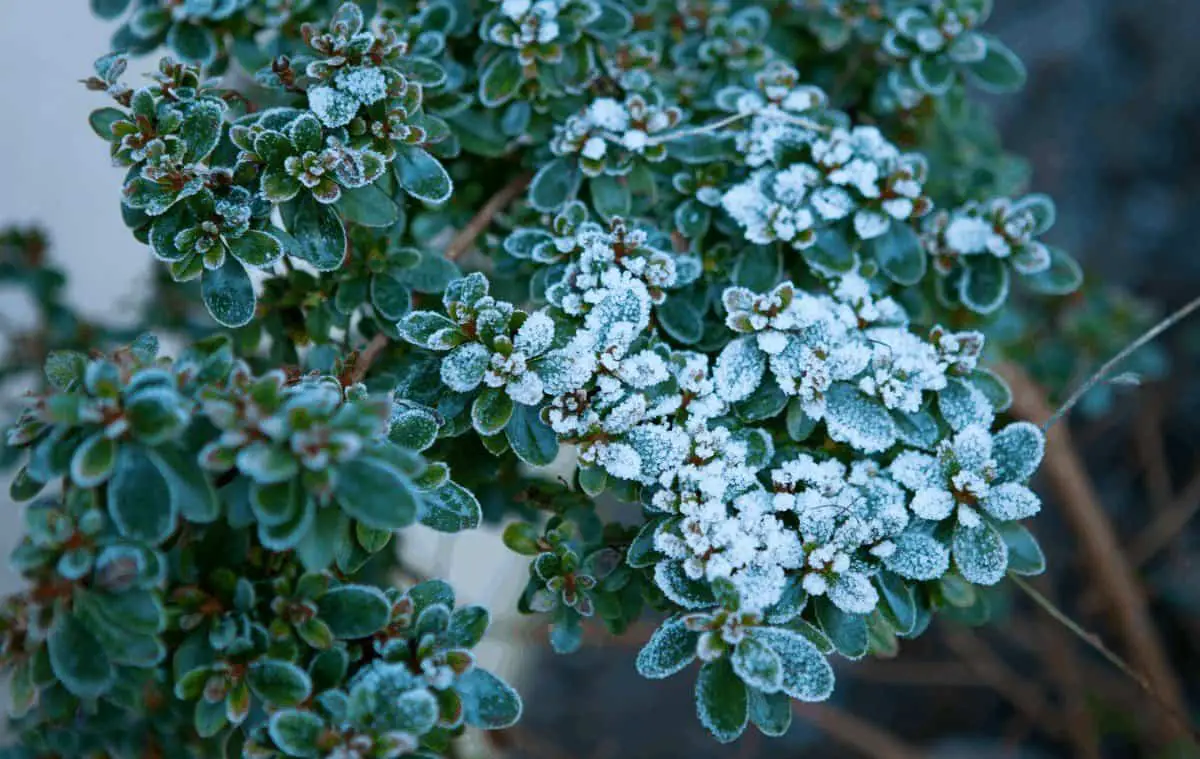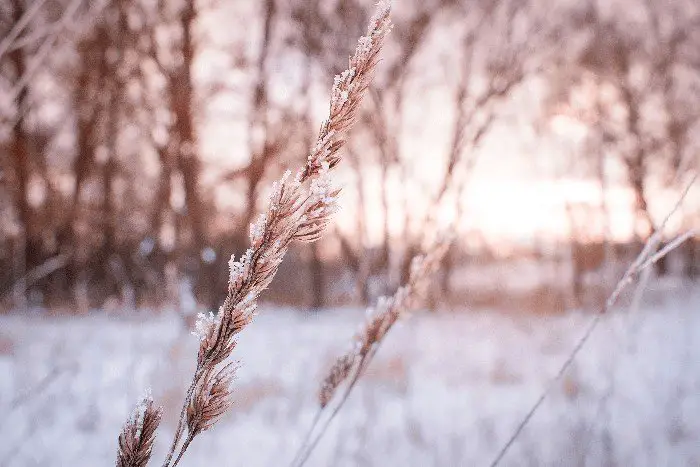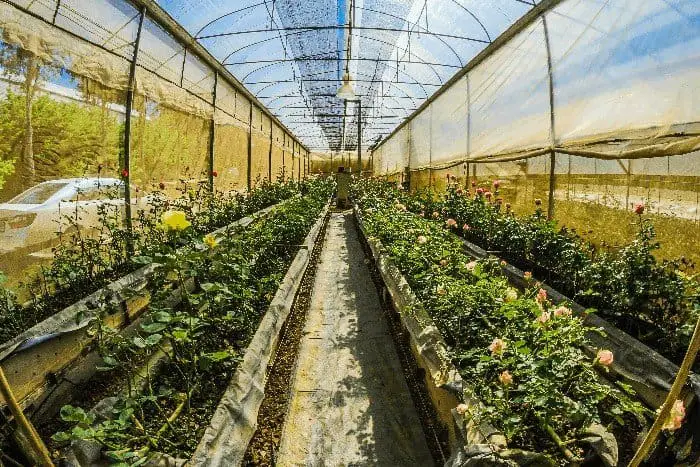Last Updated on December 26, 2022 by Tony Manhart
Many outdoor plants don’t do so well under freezing conditions. This is why as a responsible gardener; it is your responsibility to ensure that you keep your plants protected during winter. Frost harms your plants when ice crystals form on plant cells. This reduces the water available to plant cells and affects the flow of fluid within the tissues. Leaves that are damaged from frost appear darker in color and are usually shriveled and soaked with water. This means that it is important to protect plants from frost.
One of the best methods you can use to protect your plants in winter is to cover them. But you can’t just use anything to cover your plant. In this article, we will be discussing what to cover your plants to keep them from freezing.
Protect Plants from Frost: Protecting Your Plants in Winter
Freezing winter temperatures are not only unfriendly to the human skin, but it also has a negative effect on your plants’ health. While there isn’t much you can do about the weather condition, you can take some preventive measures to keep your plants safe from the cold.
The best time to start preparing your plants for winter is in fall. This is when you should carry out the maintenance procedures outlined below.
Protect Plants from Frost: What to Cover Plant with During Winter?
Plants have different tolerance to temperature changes. There are plants that are able to withstand short term freezing. These plants are referred to as hardy plants and usually have a tough cellular structure that can tolerate early winter conditions. You will still have to keep them protected from extreme weather by covering them once winter sets in.
Plants such as citrus, avocado, and other succulent crops are easily killed in cold freezing temperatures. This is because they are tender plants with a weak cell structure that doesn’t support extreme temperatures. The environments you plant your crops in also determine the preventive measure to adopt to tackle extreme weather. If you reside in an area that is prone to freezing and frost, then it is important that you know what to cover your plants to protect them from freezing.
-
Mulch It
Mulching is a good preventive measure to keep your plants dry during the winter months. It functions as an insulator that helps to trap moisture and heat in the soil. Use mulch to keep the root system of your plants from freezing temperatures.
When applying mulch to your soil, it is best to do this before the cold weather sets in. You can start this process towards the end of fall or once you begin to notice a drop in temperature. Ordinarily, you don’t want to wait till it begins to snow before you apply mulch to your soil. This is because your plant may already be finding it difficult to retain water and heat which can affect growth and development.
There are cheaper mulch options such as pine straw and wheat. They are effective at trapping heat and easy to remove once you need to expose your soil to direct heat.
-
Use a Blanket
A frost blanket is not only good for keeping you warm; it can also protect your plants from the cold too. An old blanket or cover cloth can help to protect tender plants from extreme freezing temperatures. When making use of a blanket to protect your plants, you want to ensure that you spread it carefully so as not to damage the plant.
You should ensure proper care by avoiding direct contact with the branches and leaves of your plant. Use stakes to prop up the blanket. This should help to prevent direct contact with the plant which could lead to damage. This is a good preventive measure to protect your plants from frost as the blanket won’t lead to temperature increase.
If you experience strong winds, you will have to tie down the cloth or simply drop a weight on it to keep it from blowing away. You should also remove the blanket during the day so your plant can get access to air and light. These are two important elements for plant growth and shouldn’t be compromised even during winter.
-
Build a Green House
If you can, build a greenhouse or a cold frame to keep your plants protected from freezing temperatures. This you can easily do by bending lean metal rods into a disk shape and burying the ends into the ground. This should be done across a garden row to ensure tightness. You can then make use of a fabric to cover the plant. Ensure that the fabric runs across the length of the loop to ensure maximum protection.
If this is properly done, your plants should be well protected from frost and get enough heat trapped inside the greenhouse. This is a good solution to cover your plants from freezing temperatures.
Check these DIY high tunnel Greenhouse Kit from Boost trap farmer.
-
Water Your Plants
Yes, you read right! Water can act as a cover for your plant during cold weather. Heavily watered soil has the ability to trap in heat compared to when the soil is dry. The slow evaporation of the plant helps to heat the air around your plants. While this method is a good precaution for a cold night or two, it isn’t advisable to do this in winter weather.
You shouldn’t water soil that is already frozen, as this can worsen the conditions of the plant. Instead, find a heat source to dry out the frozen soil and then either mulch or build a greenhouse over it.
-
Take Potted Plants Indoors
You can also protect potted plants from freezing temperatures by simply taking them indoors. This is the easiest possible solution to protect your potted plants from extreme winter weather.
Remember to place your potted plants close to a window with enough light exposure. Windows facing the east and west get enough access to light compared to windows facing the north and south.
Protect Plants from Frost, Final Words
Plants don’t do too well in the snow and you should endeavor to take preventive measures to ensure they survive. You can try mulching or building a simple greenhouse if you are wondering what to cover your plants with from freezing temperatures.
What methods do you use in keeping your plants safe during winter? We will like to hear from you in the comment section.
FAQs
Will plastic bags protect plants from frost?
During the winter, people want to protect plants inside their homes or greenhouses with plastic bags. Some argue that it will help the plants from frost.
The results in this study showed that plastic bags do not protect plants from frost and instead cause harmful effects on the plant’s health when they are used during the winter.
Plastic bags have been under intense debate for more than a decade because of its harmful effects on environment and animals. Plastic bags lead to increased energy consumption, water pollution, and even harm human health by releasing toxic chemicals into the atmosphere
Can I cover plants with paper bags?
The answer is yes. Although it may be harder to protect the plants without water or sunlight, there are a few ways to do that.
One way is to put a few paper bags on top of the plant and seal them off completely. Another option is to put a plastic bag on top of the plant and then cover it with another layer of plastic bags.
Plant-Covers: There are also many different types of covers for plants out there that people can use too. One popular option that people use is plastic garden pots because they're hard to tear open and easy to close after plants are in them.
Will cardboard boxes protect plants from frost?
Cardboard boxes are often used on cold winter days to keep outdoor plants safe from freezing temperatures. There are different ways that gardeners have found to make cardboard boxes work best, but they all come down to insulation and protecting the leaves of plants. A few approaches include spraying with a water bottle or adding soil or mulch inside of a box in order to provide insulation against frost damage.
Can I use burlap to cover plants?
No. Burlap has a similar texture to sand and in most cases, plants will have problems keeping their leaves hydrated and will not grow properly.
In most cases, burlap is too fine of an insulator that it is difficult for water to pass through. This means that it would actually harm the plant instead of protecting it.
At what temperature should I cover my plants?
Plants need to be in a certain temperature range for them to survive. If the temperature outside is too cold or too hot, they will not be able to live and thrive.
The term 'dormancy' refers to the period of time when a plant is inactive. When it goes dormant, plants are able to conserve their energy while they wait out the colder or warmer season without needing any care at all.
When it comes to covering your plants in winter, you should make sure that they are not exposed to direct sunlight and you should cover them more than what they would be covered in summer. This is because it also takes more time for leaves to recover when they are exposed to cold temperatures.
How do I protect my plants from spring freeze?
If you want to protect your plants from freeze this spring, you need to know how to keep them safe. Here are some tips on how to prevent them from getting killed by the cold and timing is everything.
Preventative measures:
- Make sure the soil has good moisture.
- Keep a layer of mulch or hay over the plants.
- Cover pots with burlap, newspapers or cardboard so they stay warm during the night.
- Place lights near your plants that can give off heat for hours at a time.
Tony Manhart is a passionate gardener who has been tending to gardens for over 20 years. He takes pride in creating beautiful outdoor spaces with plants, trees, and shrubs that can thrive in any environment. He loves to share his knowledge with others and has taught classes on gardening basics and advanced techniques. He is committed to sustainability, using natural and organic methods to create and maintain gardens. He also works with local organizations to create green spaces for communities. When he’s not gardening, Tony enjoys hiking, reading, and spending time with his family.




